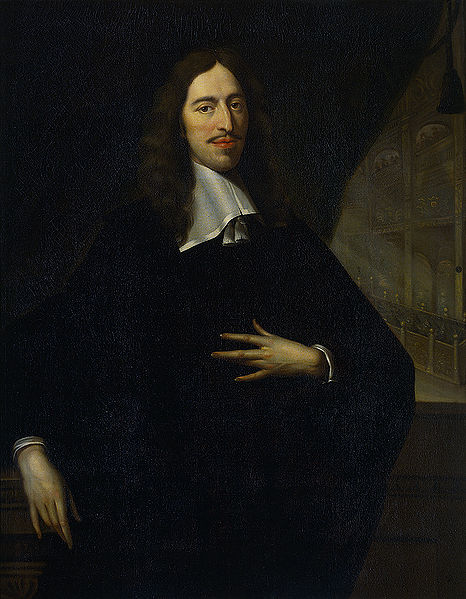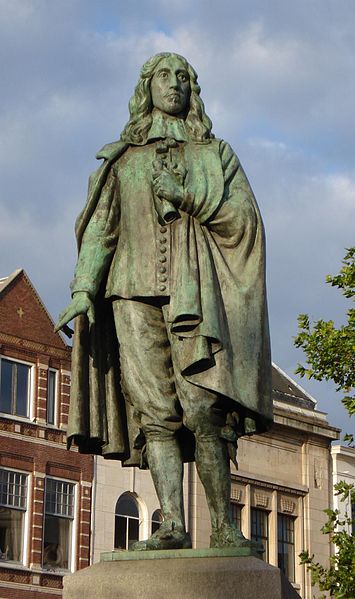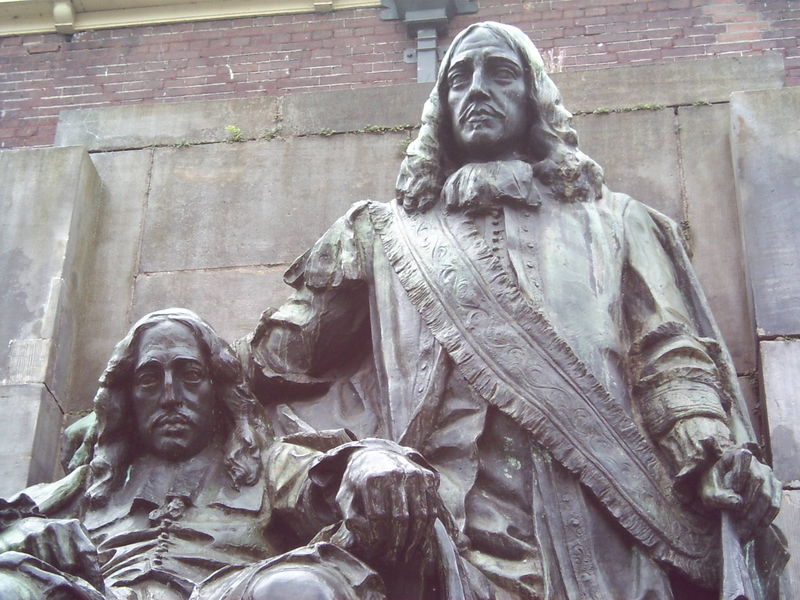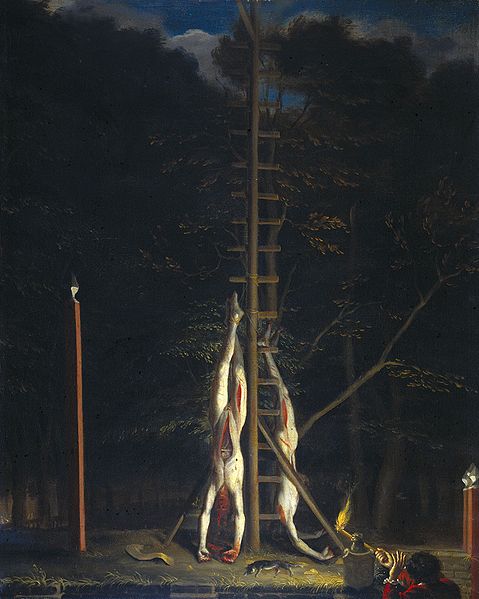<Back to Index>
- Physician and Biochemist Severo Ochoa de Albornoz, 1905
- Sculptor Antoine Louis Barye, 1796
- Grand Pensionary of Holland Johan de Witt, 1625
PAGE SPONSOR



Johan de Witt, heer van Zuid- en Noord-Linschoten, Snelrewaard, Hekendorp and IJsselveere (Dordrecht, 24 September 1625 – The Hague, 20 August 1672) was a key figure in Dutch politics in the mid 17th century, when its flourishing sea trade in a period of globalization made the United Provinces a leading European power during the Dutch Golden Age. De Witt controlled the Netherlands political system from around 1650 until shortly before his spectacular death in 1672 working with various factions from nearly all the major cities, especially his hometown, Dordrecht, and the city of birth of his wife, Amsterdam.
Johan de Witt was a member of the old Dutch patrician family De Witt. His father was Jacob de Witt, an influential city regent and burgher from the patrician class in the city of Dordrecht, which in the seventeenth century, was one of the most important cities of the dominating province of Holland. Johan and his older brother, Cornelis de Witt, grew up in a privileged social environment in terms of education, his father having as good acquaintances important scholars and scientists, such as Isaac Beeckman, Jacob Cats, Gerhard Vossius and Andreas Colvius. Johan and Cornelis both attended the Latin school in Dordrecht, which imbued both brothers with the values of the Roman Republic.
Johan de Witt married on 16 February 1655 Wendela Bicker (1635 –
1668), the daughter of Jan Bicker (1591 – 1653), an
influential patrician from Amsterdam, and Agneta de Graeff van Polsbroek (1603 –
1656). Jan Bicker served as mayor of Amsterdam in 1653.
De Witt became a relative to the strong republican
minded brothers Cornelis and Andries de Graeff, and to Andries Bicker. The couple had four
children, three daughters and one son. After De Witt's
death, his cousin Pieter de Graeff became a
guardian over his children.
After having attended the
Latin school in Dordrecht, he studied at the University of
Leiden, where he excelled at mathematics and law. He received his doctorate from
the University of Angers in
1645. He practiced law as an attorney in The Hague as an
associate with the firm of Frans van Schooten. In 1650 he was
appointed leader of the deputation of Dordrecht to
the States of Holland,
the year that
stadtholder William II of
Orange died.
In 1653 De Graeff have made De Witt a 'Grand pensionary'
of the States of Holland.
Since Holland was the Republic's most powerful
province, he was effectively the political leader
of the United Provinces as a whole. That is why
the raadpensionaris of
Holland was also referred to as the Grand Pensionary — in
many ways similar to a modern Prime Minister.
Together with De Graeff, De Witt brought about peace with England after the First Anglo - Dutch War with the Treaty of Westminster in the year 1654. The peace treaty had a secret annex, the Act of Seclusion, forbidding the Dutch ever to appoint William II's posthumous son as stadtholder. This annex had been attached on instigation of Cromwell, who felt that since William III was a grandson of the executed Charles I, it was not in the interests of his own republican regime to see William ever gain political power. On 25 September 1660 the States of Holland under the prime movers of De Witt, De Graeff, his younger brother Andries de Graeff and Gillis Valckenier resolved to take charge of William's education to ensure he would acquire the skills to serve in a future — though undetermined — state function. Influenced by the values of the Roman republic, De Witt did his utmost anyway to prevent any member of the House of Orange from gaining power, convincing many provinces to abolish the stadtholderate entirely. He bolstered his policy by publicly endorsing the theory of republicanism. He is supposed to have contributed personally to the Interest of Holland, a radical republican textbook published in 1662 by his supporter Pieter de la Court.
De Witt's power base was the wealthy merchant class into which he was born. This class broadly coincided politically with the "States faction", stressing Protestant religious moderation and pragmatic foreign policy defending commercial interests. The "Orange faction", consisting of the middle class, preferred a strong leader from the House of Orange as a counterweight against the rich upper classes in economic and religious matters alike, although leaders that did emerge from the House of Orange rarely were strict Calvinists themselves. In the period following the Treaty of Westminster, the Republic grew in wealth and influence under De Witt's leadership. De Witt created a strong navy, appointing one of his political allies, Lieutenant - Admiral Jacob van Wassenaer Obdam, as supreme commander of the confederate fleet. Later De Witt became a personal friend of Lieutenant - Admiral Michiel de Ruyter. The Second Anglo - Dutch War began in 1665, lasting until 1667 when it ended with the Treaty of Breda, in which De Witt negotiated very favorable agreements for the Republic after the partial destruction of the British fleet in the Raid on the Medway, initiated by De Witt himself and executed in 1666 by De Ruyter.
At about the time the Treaty of Breda was
concluded, De Witt made another attempt at
pacification of the quarrel between the States Party
and Orangists over the position of the Prince of
Orange. He proposed to have William appointed captain
- general of the Union on reaching the age of majority
(23); on condition, however, that this office would be
declared incompatible with that of stadtholder in all
of the provinces. For good measure the stadtholderate
was abolished in Holland itself. This Perpetual Edict (1667) was
enacted by the States of Holland on August 5, 1667,
and recognized by the States - General on a four - to
- three vote in January, 1668. This edict was added by Gaspar Fagel, then Pensionary of Haarlem, Gillis Valckenier and Free Imperial Knight
Andries de Graeff, two prominent Amsterdam
regents, which abolished the stadtholderate in Holland
"for ever".
During 1672, which the Dutch refer to as the "year of disaster" or rampjaar, France and England attacked the Republic during the Franco - Dutch War and the Orangists took power by force and deposed de Witt. Recovering from an earlier attempt on his life in June, he was lynched by an organized mob after visiting his brother Cornelis in prison. He had been duped into this trap by a forged letter requesting the visit.
After the arrival of Johan de Witt, the city guard was sent away on a pretext to stop farmers who were supposedly engaged in pilfering. Without any protection against the assembled mob, the brothers were dragged out of the prison and killed next to a nearby scaffold. Immediately after their deaths, the bodies were mutilated and fingers, toes, and other parts of their bodies were cut off. Other parts of their bodies were eaten by the mob. The heart of Cornelis de Witt was exhibited for many years next to his brother's by one of the ringleaders, the silversmith Hendrik Verhoeff.
Today some historians believe that his
adversary and successor as leader of the government, stadtholder William III of Orange, was involved in
the de Witt brothers' deaths. At the very
least he protected and rewarded their killers. The
ringleaders were Johan Kievit and his
brother - in - law Cornelius Tromp, and Johan van Banchem.
Besides being a statesman Johan de Witt, also was an accomplished mathematician. In 1659 he wrote "Elementa Curvarum Linearum" as an appendix to his translation of René Descartes' "La Géométrie". In this, De Witt derived the basic properties of quadratic forms, an important step in the field of linear algebra.
In 1671 his Waardije van Lyf - renten naer Proportie van Los - renten was published ('The Worth of Life Annuities Compared to Redemption Bonds'). This work combined the interests of the statesman and the mathematician. Ever since the Middle Ages, a Life Annuity was a way to "buy" someone a regular income from a reliable source. The state, for instance, could provide a widow with a regular income until her death, in exchange for a 'lump sum' up front. There were also Redemption Bonds that were more like a regular state loan. De Witt showed - by using probability mathematics - that for the same amount of money a bond of 4% would result in the same profit as a Life Annuity of 6% (1 in 17). But the 'Staten' at the time were paying over 7% (1 in 14). The publication about Life Annuities is seen as the first mathematical approach of chance and probability. After the violent deaths of the brothers the 'Staten' issued new Life Annuities in 1673 for the old rate of 1 in 14.
In 1671 De Witt conceived of a life annuity
as a weighted average of annuities certain where the
weights were mortality probabilities (that sum to
one), thereby producing the expected value of the
present value of a life annuity. Edmond Halley’s (of comet fame)
representation of the life annuity dates to 1693, when
he re-expressed a life annuity as the discounted value
of each annual payment multiplied by the probability
of surviving long enough to receive the payment and
summed until there are no survivors. De Witt's
approach was especially insightful and ahead of its
time. In modern terminology, De Witt treats a life
annuity as a random variable and its expected value is
what we call the value of a life annuity. Also in
modern terminology, De Witt's approach allows one to
readily understand other properties of this random
variable such as its standard deviation, skewness,
kurtosis, or any other characteristic of interest.
The lynching of the De Witt brothers is depicted with a dramatic intensity in the first four chapters of The Black Tulip, a historical fiction novel written by Alexandre Dumas, père in 1850, and this event has implications for the whole plot line of the book.
In its time, Dumas's book helped make this
tragedy known to a French readership
(and a readership in other countries into whose
languages the book was translated) who were otherwise
ignorant of Dutch history.

